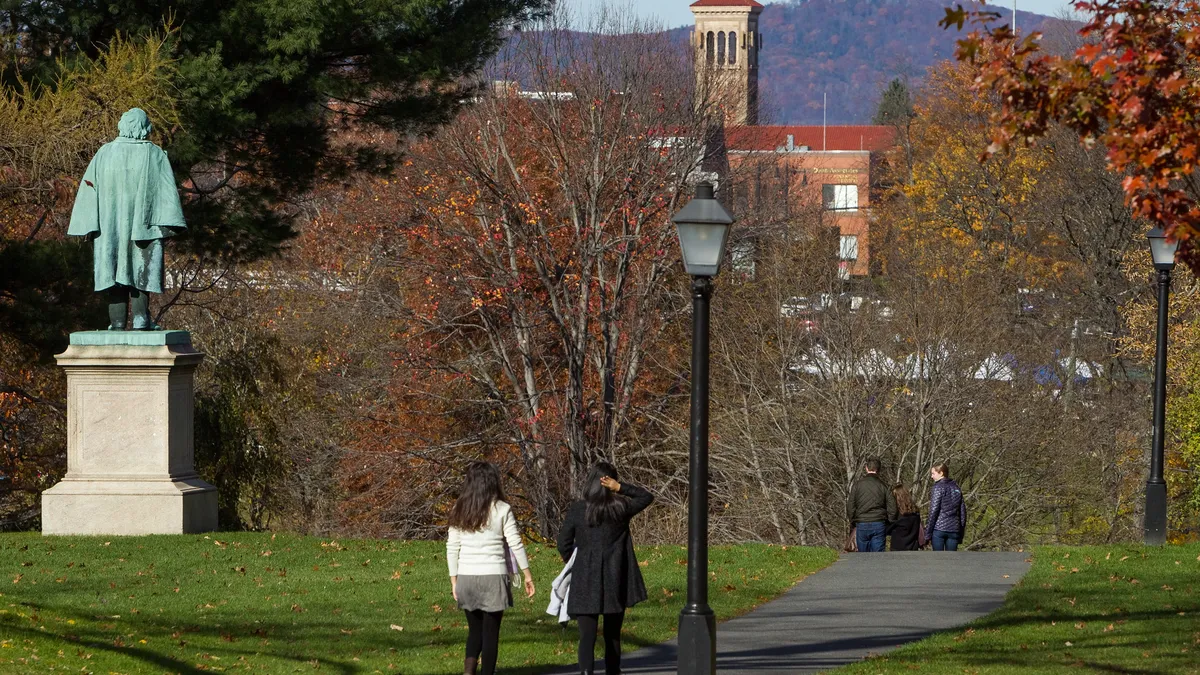Dive Brief:
- Amherst College, a highly selective liberal arts institution in Massachusetts, announced Wednesday it is ending the practice of giving children of alumni preference in admissions.
- The move makes Amherst one of the first top-ranked liberal arts colleges to abandon legacy admissions. These policies have faced new scrutiny in recent years as the sector reckons with admissions practices that favor privileged applicants.
- Amherst is also boosting its financial aid commitment from $67 million to $71 million a year, which it said will help support more low- and moderate-income students. The college said it will subsidize costs for 60% of its students.
Dive Insight:
Critics of legacy admissions argue they benefit already privileged students while boxing out those who have been historically underrepresented in higher ed.
The practice dates to the 1920s, and is linked to racism, as elite institutions employed it to curtail Jewish and other immigrant enrollment.
Most highly ranked colleges, including almost all top liberal arts schools, have maintained legacy enrollment, despite it coming under fire. Such criticism has been renewed in the wake of admissions scandals such as Varsity Blues, in which wealthy and celebrity parents allegedly bribed their childrens' way into prominent institutions.
Effects of these policies are well-documented. One study in 2011 of 30 highly selective colleges estimated that students' legacy status made them three times more likely to gain admission compared to nonlegacies. At Harvard University, legacy students were five times more likely to be admitted versus their counterparts, according to admissions data from 2010 to 2015, a fact disclosed during a lawsuit against the institution.
At Amherst, about 11% of students were legacy admits in recent classes. It enrolled 1,745 undergraduates in fall 2020, according to federal data.
"Now is the time to end this historic program that inadvertently limits educational opportunity by granting a preference to those whose parents are graduates of the College,” Amherst President Biddy Martin said in a statement. “We want to create as much opportunity for as many academically talented young people as possible, regardless of financial background or legacy status."
Amherst is need-blind, meaning it does not account for family income when making admissions decisions. It also meets students' full demonstrated financial need without packaging loans.
The college netted $66.1 million in tuition and fee revenue in 2020, after subtracting financial aid, according to audited financial statements. Its endowment distribution totaled nearly $116 million, more than half of its $222.4 million in total operating revenue.
Amherst also on Wednesday announced a refreshed grant initiative. It will offer high-need students annual grants for living expenses such as winter coats or laptops. The college also reduced work-study requirements from six to four hours per week, and it cemented an emergency fund for students.
The institution's decision on legacy status will likely fuel the movement to excise the practice from college admissions. Johns Hopkins University, a well-known research institution in Baltimore, scaled back legacy admissions beginning in 2014 before formalizing the move in 2019.
In 2009, the share of legacy students in Johns Hopkins' first-year class was more than 12%, and the percentage of those who were eligible for federal Pell Grants, a proxy for low-income status, was 9%. Now, those numbers are essentially reversed. Last year's first-year class had 3.5% with legacy connections, and roughly 19% were Pell-eligible.
And this year, Colorado passed a law banning legacy admissions at the state's public institutions. The state's governor said when he signed the law these rules disproportionately hurt applicants who are first-generation, students of color and those who came to the U.S. illegally.













